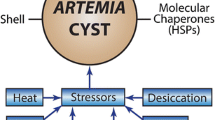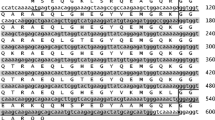Abstract.
Cells of encysted embryos of Artemia franciscana, the brine shrimp, are among the most resistant of all animal cells to extremes of environmental stress. We focus here on their ability to survive continuous anoxia for periods of years, during which their metabolic rate is undetectable. We asked whether their impressive tolerance was reflected in changes at the ultrastructural level. The ultrastructure of encysted embryos previously experiencing 38 days and 3.3 years of anoxia was compared with those not undergoing anoxia (controls). Rough endoplasmic reticulum was abundant in anoxic embryos, in spite of the absence of protein biosynthesis in their cells. Other cytoplasmic changes had occurred in the anoxic cells, but overall their structure was remarkably intact, in view of their 3 years of continuous anoxia. A major difference was the presence of abundant electron-dense granules in the nuclei of anoxic embryos; these were present but rare in nuclei of controls. Biochemical fractionation and Western immunoblotting confirmed previous observations that substantial amounts of the small heat shock/α-crystallin protein (p26) translocated into nuclei of anoxic embryos. We have no evidence that the dense granules contain this protein, but that remains a possibility. In contrast, and contrary to expectation, proteins of the hsp70 and 90 families did not undergo anoxia-induced nuclear translocation, an unusual result since such translocations have been widely observed in cells from a variety of organisms.
Similar content being viewed by others
Author information
Authors and Affiliations
Additional information
Electronic Publication
Rights and permissions
About this article
Cite this article
Clegg, J., Jackson, S. & Popov, V. Long-term anoxia in encysted embryos of the crustacean, Artemia franciscana: viability, ultrastructure, and stress proteins. Cell Tissue Res 301, 433–446 (2000). https://doi.org/10.1007/s004410000249
Received:
Accepted:
Issue Date:
DOI: https://doi.org/10.1007/s004410000249




